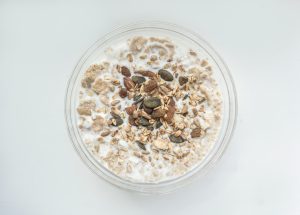Traditional Chinese Medicine
Breakfast Congee Ideas

For anyone who is vegan, sensitive to eggs, or just dislikes them, here is a breakfast idea I’ve been experimenting with, both for the sake of variety and, well… experimentation.
In China, (white) rice congee is a common breakfast, often with egg and pickled vegetables, although I realize in the States rice is rather vilified for being a simple carb and high on the glycemic index. While this might be the case, it is also a food that is very gentle on the stomach and internal organs, which from our perspective aids in absorption and digestion, and in the proper dosages can be beneficial. However, for those who can’t get past the glycemic index, I recommend using quinoa, millet, or amaranth.
1 cup of your grain of choice
5 cups of liquid (if you’re going to make the sweeter, I recommend some kind of dairy-free milk—if you’re going for the probably healthier, more Oriental style I recommend just water or either vegetable, beef, or chicken broth) Oils don’t mix as well with the sweet flavors so if you’re making the sweeter version be sure to stir often so as to avoid sticking to the pot.
Boil and simmer about 15-25 minutes, or until it is the consistency of porridge.
Treat the sweet version like you would oatmeal: Top with berries, granola, as little maple syrup as you can discipline yourself to, cinnamon, and/or nuts if you like.
For the Asian version I recommend leftover vegetables and/or pickled cabbage or kraut. Plus, an over-easy or boiled egg if you want the best of all worlds.
Enjoy warm if possible! For those of us with babies or toddlers, we long for the days when we will return to eating hot food.
Whatever you eat, EAT BREAKFAST. I cannot stress this enough. They said breakfast is the most important meal of the day because it is, not because grandma said it, but because science and biology do. Here is a link to an NIH study correlating the skipping of breakfast with increased insulin resistance and risk for diabetes: https://www.ncbi.nlm.nih.gov/pmc/articles/PMC7246451/
I like coffee as much as anyone, but coffee alone (or with a piece of toast) is not breakfast. Protein and/or fat should be consumed, preferably in great quantity.
Nor do I doubt the potential benefits of intermittent fasting, but it is more biologically aligned to skip dinner—not breakfast. If this is impossible, maybe a later breakfast, like 9am? Supposedly, any longer than 2-3 hours after waking constitutes “skipping breakfast,” which is to say the insulin resistant mechanism is set in motion by that time.
If you have no appetite for breakfast this probably indicates your dinner being not fully digested and some metabolic syndrome at work. Please reach out—or try licorice and/or ginger tea 🙂
Acupuncture: A Gentle Touch in the Fight Against Cancer

Hearing you’ve been diagnosed with cancer can feel like getting run over by a freight train. It can be overwhelming to learn about the prognosis, treatment options, and what to expect as you begin the journey that will hopefully lead to a full recovery.
The aggressive treatments, often including chemotherapy and radiation, can leave patients feeling drained and in constant pain. What many people don’t realize is that acupuncture can be a great source of hope as it helps bring physical relief to many of the symptoms caused by traditional cancer treatments. continue reading
Benefits of Working with Allied Practitioners

How your acupuncturist can build bridges among your health care team.
Let’s see if we can set the scene of something remarkable, something that could become the future of healthcare. Picture yourself walking into a doctor’s office or health clinic looking for relief from your debilitating chronic pain. The nurse calls your name and leads you into a serene treatment room. As you settle onto the examination table, the door opens and you are greeted by not just the familiar face of your acupuncturist, but also by a team of allied practitioners working in harmony to address your health concerns. continue reading
Using Acupuncture to Manage Autoimmune Diseases

Autoimmune diseases can prove to be intricate and seemingly unsolvable puzzles for many people. And statistics prove this to be true as millions worldwide are impacted by autoimmune diseases ranging from rheumatoid arthritis to lupus, Crohn’s disease, multiple sclerosis, irritable bowel disease, and even Parkinson’s disease. Conventional medicine can diagnose 100 different autoimmune conditions, however the treatments offered don’t completely resolve the issues associated with the disease and in extreme cases, no treatment is available at all. And yet, in the midst of all these medical challenges that autoimmune diseases present, acupuncture emerges as a promising ally, offering relief to those grappling with these often-complex health conditions. continue reading
Total Solar Eclipse, 2024!
 Astrology is a bit like politics, in that I try to feel out the room before bringing it up to risking being alienated as the kooky, New Agey “acupuncture guy,” who believes in everything unproven. In fact, I feel I owe it to my profession, a system of medicine that has been repeatedly proven, to keep my affinity for the subjective or ethereal realm on the hush, at least until I’ve established some degree of intellectual and/or emotional credibility in the space.
Astrology is a bit like politics, in that I try to feel out the room before bringing it up to risking being alienated as the kooky, New Agey “acupuncture guy,” who believes in everything unproven. In fact, I feel I owe it to my profession, a system of medicine that has been repeatedly proven, to keep my affinity for the subjective or ethereal realm on the hush, at least until I’ve established some degree of intellectual and/or emotional credibility in the space.
Although I’ve heard of a few practitioners that take into consideration (Chinese) astrology when diagnosing patients, my understanding is that the two paradigms have nothing to do with one another. The fact that they often attract similar people is more a byproduct of western society in recent generations. I doubt during the Han Dynasty (206 BCE) in ancient China the acupuncturists were more inclined to be wary of Geminis, attracted to Pisces, or signed up for an ayahuasca retreat.
With that said, I enjoy astrology. I enjoy the psychology of it, the character trends and tendencies, and over the years I’ve observed obvious proclivities in each sign to offer part of the explanation for why people are the way they are.
On the other hand, I’ve never gotten excited about astrological forecasts. “What’s to come” for me this month or even this year, I take with the same grain of salt I do the meteorological 7-day forecast. Maybe I should, but I don’t write out my desires or intentions at each month’s new moon, frankly because when I did in the past I was always just disappointed!
However, I am quite excited and intrigued about the upcoming solar eclipse this Monday, April 8th. Supposedly a total solar eclipse is a time of major new beginnings, potentially coinciding with major terminations in our lives that are largely outside of our control. If nothing else, for something this unique I’ll at least take some time to observe, do some prayer or meditation, and dust off the old astrology pad for a list of intentions .
But don’t listen to me ramble on about it. I wouldn’t necessarily label astrology even a hobby—it’s more an interest of mine—and definitely not my formal education. If you’re curious about next week’s eclipse, I highly recommend the long-time astrology guru of NYC, Susan Miller’s Astrology Zone, here: https://www.astrologyzone.com/all-about-eclipses-a-guide-for-coping-with-them/
Good luck with everyone’s new beginnings, and see you on the other side!


